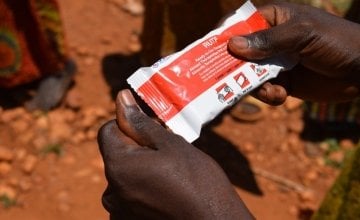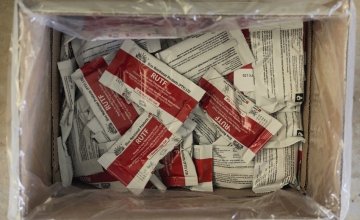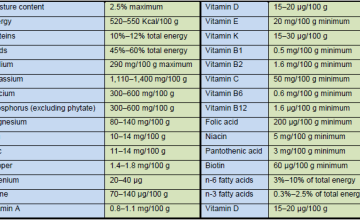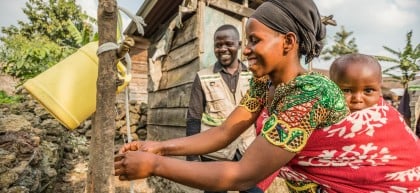
Knowledge Hub
The key to solving malnutrition? Peanuts.

There is a universal problem-solving principle known as Ockham’s Razor which maintains that the simplest explanation tends to be the right one. When it comes to global hunger, this notion may appear somewhat frivolous: if it were so simple, surely 815 million people would not still be going to bed hungry every night. However, thanks to a little foil packet filled with a soft, sticky substance, the treatment of child malnutrition may have been revolutionised with an exceptionally simple solution. Peanuts.
Malnutrition is 100% preventable. However, according to the World Health Organisation (WHO), almost half of all deaths of children under five — a total of around three million worldwide — are linked to undernutrition. Undernutrition can take several forms of which acute malnutrition, characterized by rapid weight loss and also known as wasting, is the most prevalent one. In essence it means a person is not getting enough food; or not getting the right types of food (i.e. they’re missing out on essential nutrients like protein or iron), or are unable to properly absorb the nutrients they need because of sicknesses like diarrhoea.
For decades, health and humanitarian organisations – including Concern Worldwide – have searched for alternatives to treating malnourished children during crises and emergencies to replace the traditional milk based diet provided through clinical settings. In many settings, particularly among the poorest and most marginalised communities, the majority of malnourished children are not brought to a health facility at all. Many factors impede care-seeking in health facilities, including the distance from and time spent going to the centre; cost of treatment and transport; and the duration of the therapeutic milk treatment (up to five weeks), which prevent parents and caregivers from looking after other children or going to work seeing as it must be administered as an in-patient treatment.
In addition, needing water to administer treatment is particularly dangerous in developing countries due to waterborne bacteria and disease being rife, and the requirement of hospitalisation is expensive and time-consuming, meaning children were often brought in for treatment when extremely weak, or when it was too late.
When the discovery of ready-to-use therapeutic food (RUTF) was made, the future of treating malnourished children was changed forever. This was because:
- It provides all the nutrients required for recovery.
- It has a good shelf life, and does not spoil easily even after opening.
- Since RUTF is not water based, the risk of bacterial growth is very limited, and consequently it is safe to use without refrigeration at household level.
- Babies receiving RUTF can be treated at home by their parents, reducing cost and time away from home and consequently increasing the likelihood of their mums bringing them into a clinic to receive their treatment supply in good time.
- Malnutrition death rates can be cut in half.
Changing opinions, and lives

Like most great inventions, the first peanut-based ready-to-use therapeutic food was met with hesitation and criticism. However, development of RUTF for the treatment of uncomplicated cases of acute malnutrition in young children from six months to five years of age has greatly improved survival through the ability to treat large number of malnourished children in community settings rather than at health facilities during emergencies. While it may not look like much from the outside, it has revolutionised the treatment of malnutrition across the world. Properly used, RUTF is safe, cost-effective and has saved hundreds of thousands of children lives in recent years.
RUTF has made it possible for Concern to treat thousands of children suffering from acute malnutrition, especially during an emergency. I don’t see how it would be possible for us to continue working and saving lives of so many vulnerable children without having access to RUTF.
Plumpy’nut® is the brand name for RUTF produced by Nutriset and its franchises (PlumpyField®). Originally Nutriset was the sole supplier of RUTF worldwide. However, currently there are increasing numbers of companies producing RUTF for both local and international sales, which allow not only for greater production capacity, but also for competition in the market in order to obtain best value for money.

Ockham’s truth
The genius of RUTF is in its simplicity. Clocking in at 500 calories per packet, the high-energy paste consists of peanuts, oil, sugar, milk powder, and vitamin and mineral supplements, providing all the nutrients required for recovery from acute malnutrition.
A child on a RUTF regime can go from a near-death state to relative health in a mere month.

RUTF is also liked by children. Siobhan Sheerin, senior communications officer at Concern Worldwide UK described it as tasting like “peanut butter with a load of icing sugar added”, so it’s not surprising that children aren’t very resistant when it comes to eating it. It is also safe and easy to use without close medical supervision and can be used in combination with breastfeeding. Importantly, it is formulated to have a long shelf life (three to four months without refrigeration, even at tropical temperatures), and doesn’t need to be mixed with clean water.
Another key innovation is that it can be eaten straight from the packet. No cooking is required, and it can be administered anywhere, at any time.
Humanitarian response at scale
RUTF’s principle advantage, the fact that it can be administered at home, allows for a vast scale-up in response to humanitarian emergencies. This is why it was introduced as the main weapon against malnutrition in situations of humanitarian emergencies during the early 2000s by WHO, the World Food Programme, the UN Standing Committee on Nutrition and UNICEF, and is still used to this day.
We know it works
The results of RUTFs are astonishing. With a recovery rate of 80 per cent for community based treatment of acute malnutrition, RUTFs have saved the lives of millions of children. It costs 55p to buy a sachet of this nutrient-rich therapeutic food. An average full course of treatment for a child amounts to around 10-15 kilogrammes of RUTF over a 6-8 week period, approximately one carton of RUTF (150 sachets). £10 could help buy eighteen sachets to feed a child for six days.
Concern continues to use RUTF’s to treat malnourished children. Because we know, it works.
This summer we are asking our supporters to help us providing lifesaving sachets to treat malnourished children in the Somali region of Ethiopia. After years of severe drought, 8.5 million people are without access to food and around 7.9 million people require emergency food assistance, causing the number of malnourished children and the need for therapeutic food treatments to skyrocket. An estimated 375,000 under-five-year-olds are at risk of malnutrition. But, RUTF can change this.
Once said to be as important as the discovery of penicillin, no matter what it is made of, in value it is worth anything but peanuts.
Lucy Bloxham
Digital Content Editor






